Visit the Gallerie dell’Accademia, the top art museum in Venice, to see masterpieces by Titian, Bellini, Veronese, Tintoretto, and, with a bit of luck, Leonardo da Vinci’s Vitruvian Man.
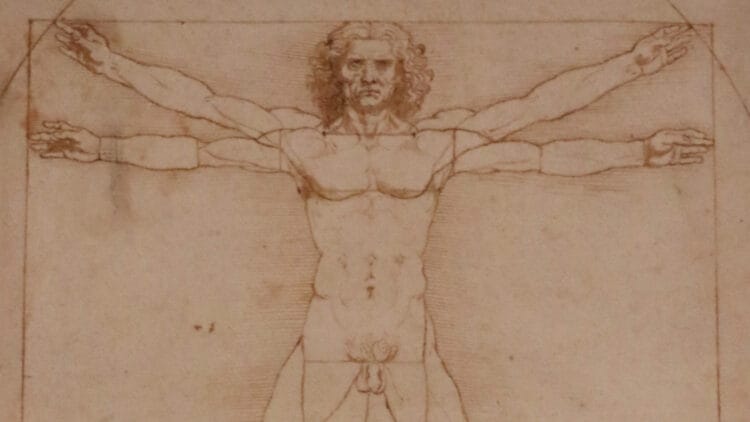
The Gallerie dell’Accademia is the top art museum in Venice with an important collection of Venetian Renaissance art. The display features over 500 paintings, sculptures, and drawings from the 14th to 18th century by artists including Titian, Tintoretto, Giorgione, Bellini, Veronese, and Carpaccio. The most famous work in the Academia Gallery, Leonardo da Vinci’s Vitruvian Man, is rarely displayed. Book guided tours and buy online time-slot reservation tickets, although the museum is often not busy.
Visit the Academia Gallery in Venice

The Gallerie dell’Accademia (Academia Gallery) is located on the Canal Grande in the Dorsoduro district of Venice. It is in the former Scuola della Carità, a historic complex with Gothic and Neoclassical elements.
The collection is the definitive showcase of pre-19th-century Venetian art with around 500 paintings, sculptures, and drawings on display.
The museum follows a roughly chronological layout starting on the upper floor. Only a small selection of early works (1300-1450) is currently being displayed as several halls are closed for renovation.
The extensive collection of paintings from 1400-1600 is also on the first floor. These include works by the Bellinis, Veronese, Titian, Hieronymus Bosch, and Tiepolo.
Works from the 17th to 19th centuries, including sculptures (and copies) by Canova, are on the ground floor. Although religious themes continue to dominate, an increasing number of paintings also illustrate mythology, nature, portraits, and cityscapes, especially of Venice.
This art museum is not overly big and easy to visit to get a good overview of Venetian art from the 14th to the 18th century. Although religious themes feature prominently, many works are easy to enjoy as the Venetians liked their art colorful, elaborate, grand, and often big.
Leonardo da Vinci’s Vitruvian Man

Leonardo da Vinci’s Vitruvian Man (Uomo vitruviano) is by far the most famous and most important work in the collection of the Gallerie dell’Accademia in Venice. Unfortunately, it is rarely displayed due to its fragility.
Da Vinci’s Vitruvian Man is one of the most iconic images in the history of art and science. Created around 1490 in pen and ink, it depicts a male figure in two overlapping positions with arms and legs extended, inscribed within both a circle and a square.
This drawing is Leonardo’s visual interpretation of ideal human proportions as described by the ancient Roman architect Vitruvius, who believed that the human body was a model of symmetry and harmony that reflected the perfection of the universe.
In Leonardo’s rendering, the figure’s outstretched limbs demonstrate how the body can fit precisely within geometric shapes, with the navel as the center of the circle and the genitals as the center of the square.
The accompanying notes, written in Leonardo’s characteristic mirror script, outline the specific proportions: for instance, that a palm is the width of four fingers, the height of a man is four cubits, and the span of the arms equals the height.
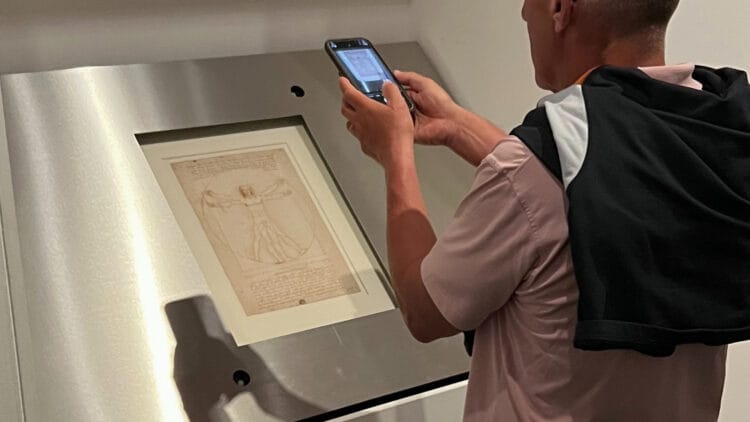
Leonardo da Vinci’s Vitruvian Man measures approximately 34.4 × 25.5 cm (13.5 × 10 inches). It is drawn in pen and brown ink over metalpoint on paper. Due to its fragility, it is normally not on display. Even when it appears in major exhibitions, it is behind special glass and revealed only every 20 minutes or so to protect it from light.
Must-See Masterpieces in the Galleria dell’Accademia in Venice

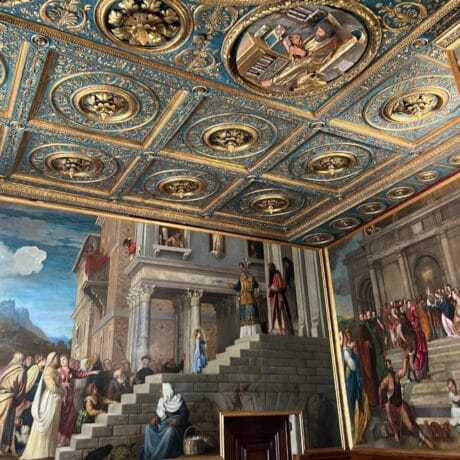
Some of the highlights in the Academy Gallery in Venice, in no particular order, include:
Titian: Pietà (Pietà) Titian’s final, unfinished work—dark, expressive, and deeply personal, intended for his own tomb in the nearby Frari Church.
Titian: Presentation of the Virgin in the Temple (Presentazione della Vergine al Tempio). A grand, architectural scene showing the young Virgin ascending temple steps, rich in detail and dramatic composition.
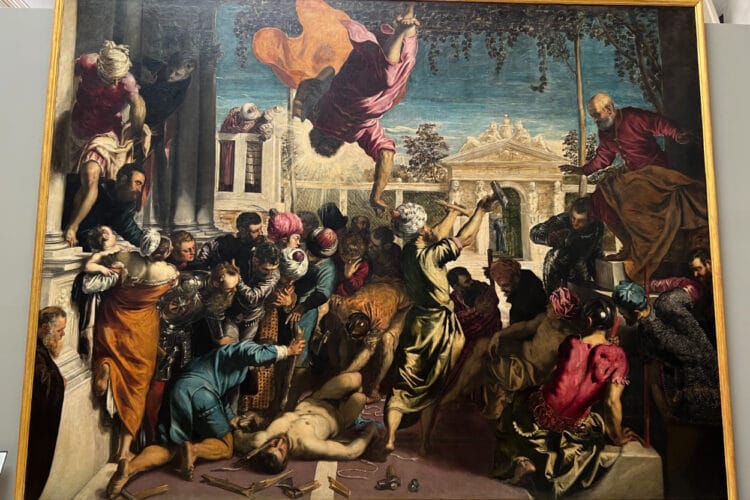
Tintoretto: The Miracle of the Slave (Il miracolo dello schiavo) Saint Mark descends from heaven to save a slave, in a whirlwind of motion and dramatic light.
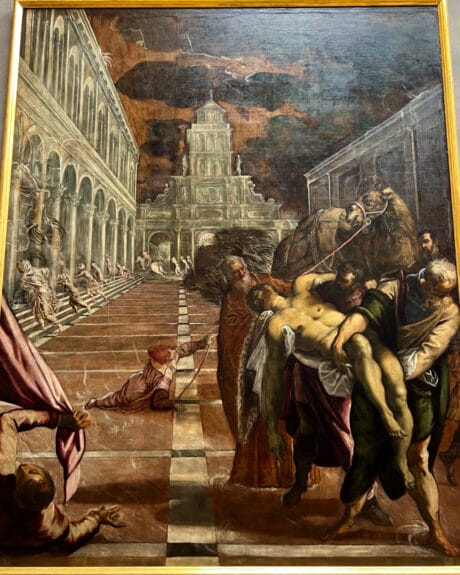
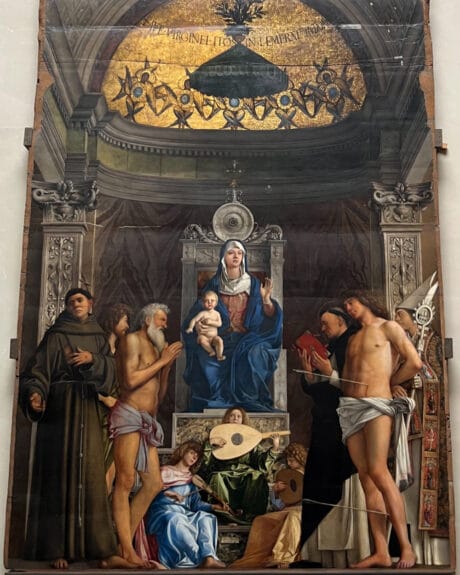
Tintoretto: Saint Mark’s Body Brought to Venice (Il trasporto del corpo di San Marco). A mysterious, nocturnal scene filled with flickering light and supernatural intensity.
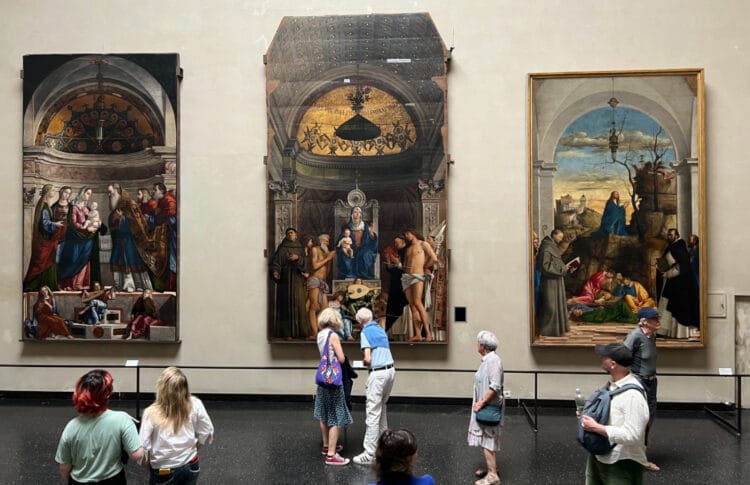
Giovanni Bellini: San Giobbe Altarpiece (Pala di San Giobbe). A majestic sacra conversazione with the Madonna and Child enthroned among saints and musicians, bathed in soft light and architectural harmony.
Giovanni Bellini: Madonna and Child between Saints Catherine and Mary Magdalene (Madonna col Bambino tra Santa Caterina e Maria Maddalena). A serene and luminous sacra conversazione set against a gentle Venetian landscape.
Giovanni Bellini: Presentation of Jesus in the Temple (Presentazione di Gesù al Tempio). Early Renaissance clarity and quiet emotion in a solemn religious ritual.
Vittore Carpaccio: Miracle of the Relic of the Cross at the Rialto Bridge (Miracolo della reliquia della Croce al ponte di Rialto) A vivid slice of 15th-century Venice, blending daily life with the miraculous. (It is currently being restored)
The Feast in the House of Levi
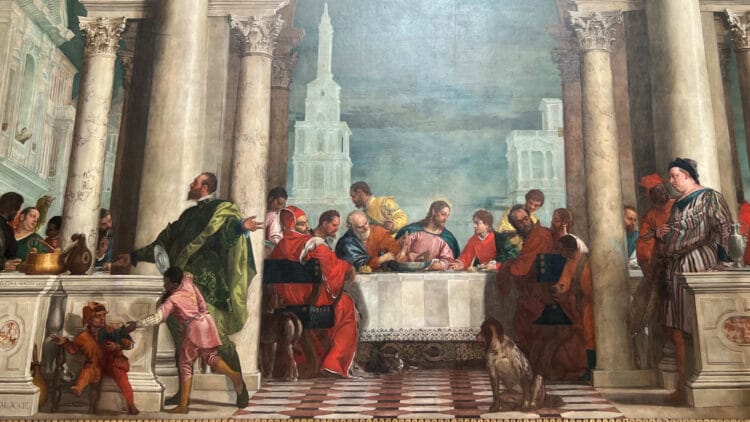
Veronese: The Feast in the House of Levi (Convito in casa di Levi). An enormous, theatrical banquet scene filled with color, life, and architectural grandeur. Originally, The Last Supper until the inquisition found it too jolly for such a momentous event.
Giorgione: The Tempest (La tempesta). A mysterious landscape with a stormy sky, a nude woman, and a soldier—enigmatic and poetic.
Lorenzo Lotto: Portrait of a Young Gentleman in his Studio (Ritratto di giovane gentiluomo nel suo studio). A psychological portrait that reveals character through gesture and setting.
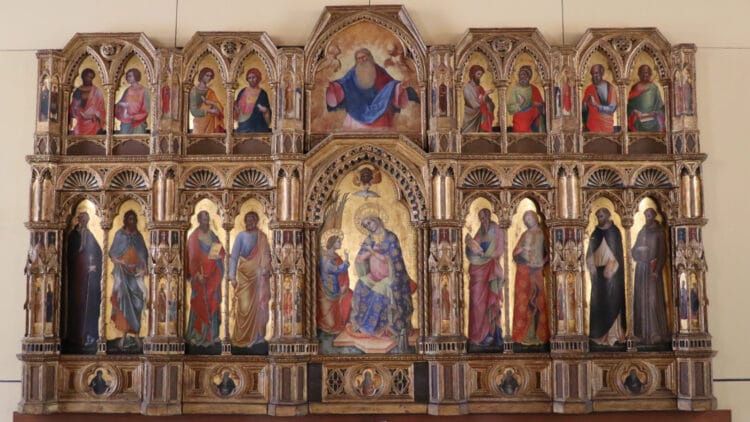
Paolo Veneziano: Polyptych of the Coronation of the Virgin (Polittico dell’Incoronazione della Vergine) and Polyptych of the Annunciation (Lion Polyptych). Gothic gold-ground altarpieces, rich with decorative detail and sacred hierarchy.
Canaletto: Capriccio with Classical Ruins (Capriccio con rovine classiche) A fantasy view combining real and imagined architecture in luminous clarity.
Sebastiano Ricci: Moses Striking the Rock (Mosè fa scaturire l’acqua dalla roccia) A dramatic Baroque scene filled with movement and divine intervention.
Andrea Mantegna (attributed): St. George (San Giorgio) A poised, armored saint standing over the slain dragon with sculptural precision.
Monumental Tiepolos
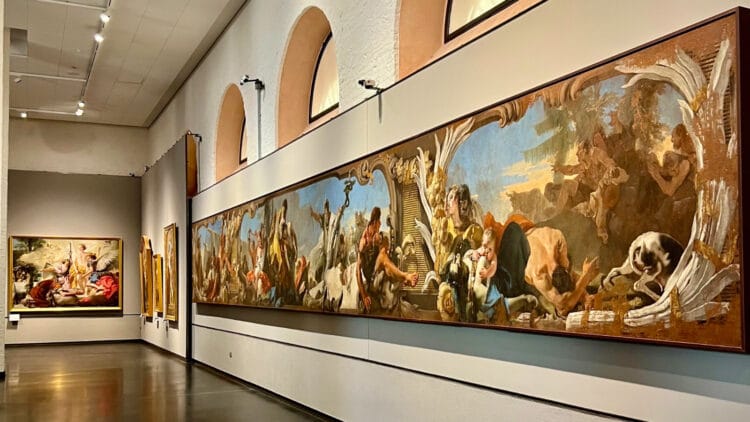
The Accademia has several large and even monumental paintings by Giambattista Tiepolo and a few by his son Giandomenico:
Giambattista Tiepolo: Scourge of the Serpents (Castigo dei serpenti). A monumental 167 cm by 1355 cm (about 5.5 feet by 44.4 feet) work with an emphasis on the tragic suffering. (Tintoretto painted a similar scene on the ceiling of the Scuola Grande di San Rocco.)

Giambattista Tiepolo: The Feast of the Cross (L’esaltazione della Croce). A 486 cm (16 ft) circular ceiling painting, now displayed upright, depicting the discovery of the True Cross by Helena, mother of Emperor Constantine.
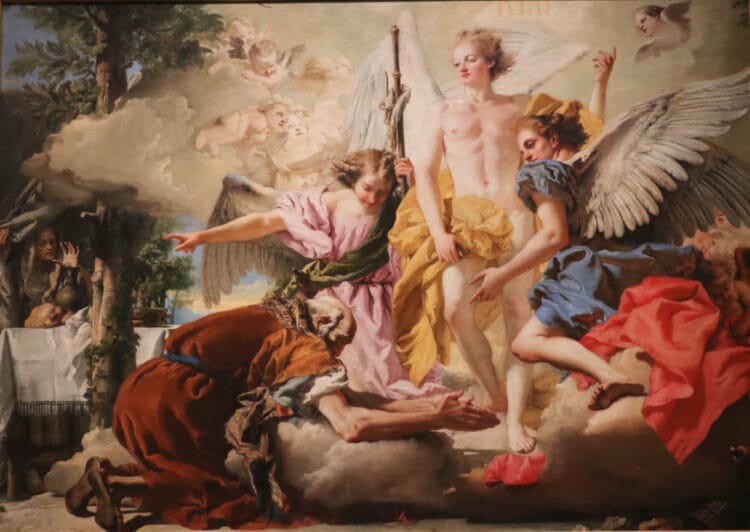
Giandomenico Tiepolo: The Three Angels Appearing to Abraham (Apparizione dei tre angeli ad Abramo). Hinting at the neo-Classical with the angel’s body inspired by the Apollo Belvedere.
Sculptures in the Accademia
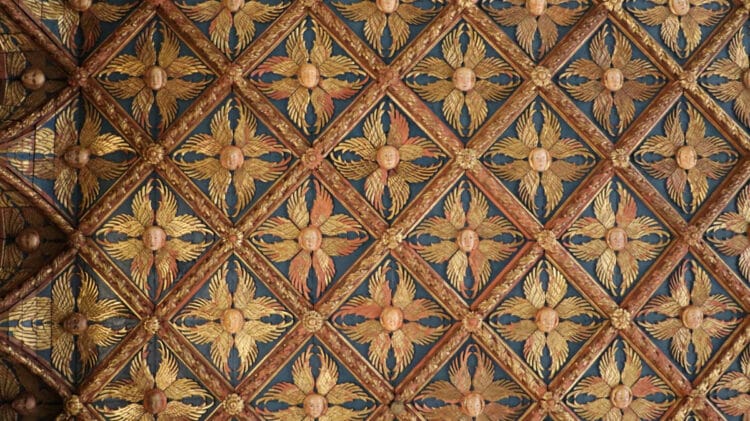
Although the Venetian paintings are the main attraction of the Accademia, the gallery also preserved some of the original architectural features from the church and school.
The original 15th-century ceilings of the Scuola Grande della Carità (Halls I & XXIV) are very impressive. Some of the oldest works in the collection are displayed here, while Titian’s Presentation of the Virgin in the Temple remains here in its original position.
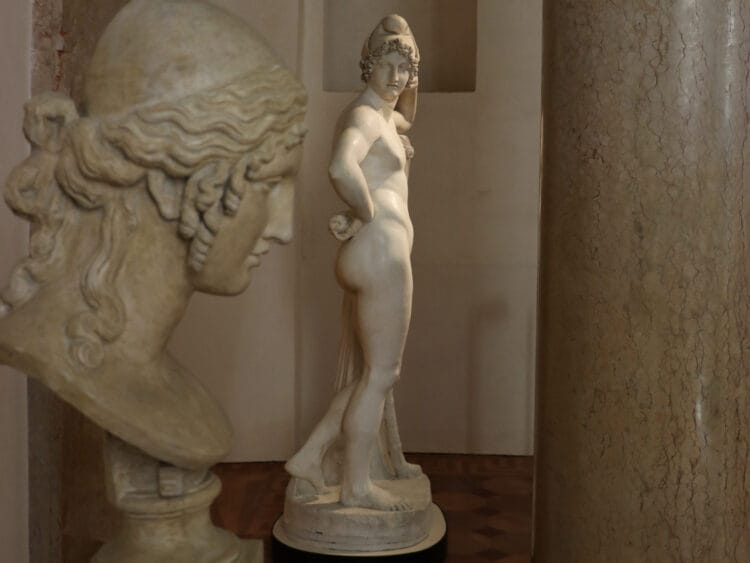
Several casts and terracotta versions of sculptures, reliefs, and designs by Antonio Canova are in the gallery and halls on the ground floor. More grim, his right hand is preserved in a small porphyry and marble urn (Room 13), while his heart is in the pyramid-shaped monument in the Friari Church in Venice.
Visitor Information

Opening Hours of the Galleria dell’Accademia in Venice
The Gallerie dell’Accademia in Venice is open daily from 9:00 to 19:00 but closes at 14:00 on Mondays.
Special exhibitions inside the Academy usually open an hour later and close an hour earlier than the main museum.
Visitors generally spend around two hours inside the Galleria dell’Arte. The museum is not overly big and certainly not an art marathon on the scale of the Uffizi in Florence or the Louvre in Paris.
Tickets and Entry
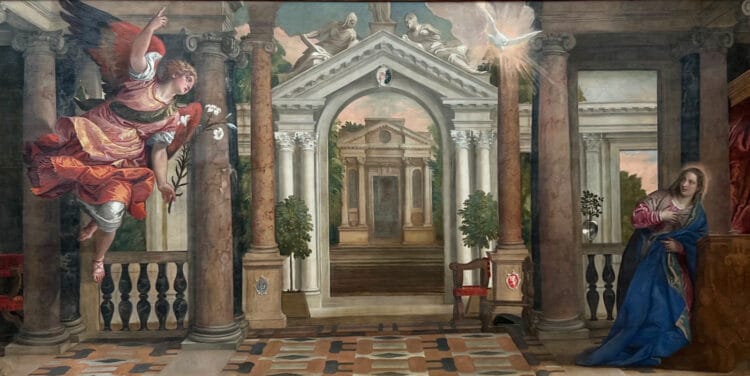
General admission tickets are €15 (and usually around €20 when special exhibitions are in progress). Separate tickets are usually not available to see the permanent and temporary exhibitions separately. Guided tours are available.
Admission is free for all children under 18. EU nationals aged 18 to 25 may buy admission for €2 via the 18APP.
It’s possible to book timed-entry tickets in advance. It is always a good idea to ensure entry, but apart from the high season (summer, Easter, and Christmas holidays), this is often not necessary. However, having a time slot for the Accademia and planning smaller sights around it is a good strategy.
Early morning or late afternoon slots tend to be less crowded.
On free admission days, including most first Sundays of the month, reservations are not possible and entry is on a first-come, first-served basis. As on regular days, a maximum of around 500 visitors are allowed inside the museum at any given time.
The Gallerie dell’Accademia in Venice, Palazzo Cini Gallery, Peggy Guggenheim Collection, Palazzo Grassi – Punta della Dogana form the so-called Dorsoduro Museum Mile. A ticket from any of these four museums gives a small discount on other admissions within a week.
Transportation to the Accademia in Venice
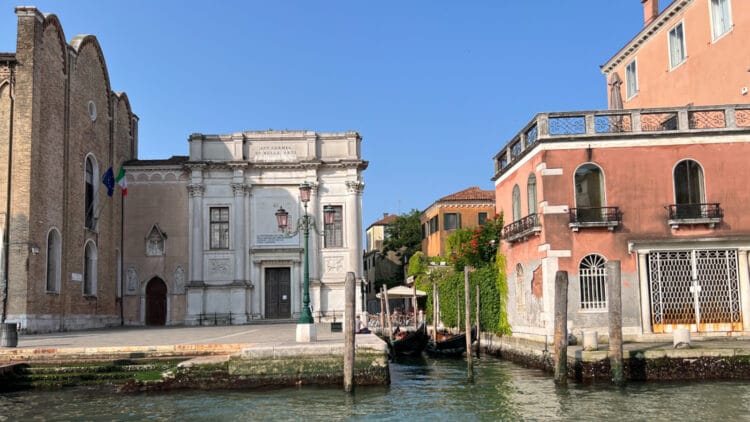
The Academy Gallery (Gallerie dell’Accademia), Campo della Carità, Dorsoduro 1050, 30123 Venice, Italy, is on the Grand Canal directly at the Accademia Bridge and Accademia vaporetto stop (line 1 or 2 from San Marco, Piazzale Roma, and Santa Lucia train station.
If not getting lost, it is around a 20-minute walk from the station or just over 10 minutes from St Mark’s Basilica.
A visit to the Accademia combines well with the more modern art on display in the Collezione Peggy Guggenheim and the Pinault Collection (at Punta della Dogana). Or to see more Venetian art in their original locations, visit the Frari Church and Scuola Grande di San Rocco en route back to the station.